United States
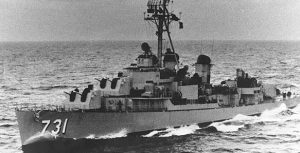 I was a born in the early days of the Vietnam War, so much of those early war years went unnoticed…by me anyway. The war official began on November 1, 1955, but there was much turmoil in the years leading up to the actual beginning of the war. It was an unpopular war, and probably the biggest news in the United States was the many protests against the war.
I was a born in the early days of the Vietnam War, so much of those early war years went unnoticed…by me anyway. The war official began on November 1, 1955, but there was much turmoil in the years leading up to the actual beginning of the war. It was an unpopular war, and probably the biggest news in the United States was the many protests against the war.
Nevertheless, there were some big operations that took place in the Vietnam War years. One such operation was Operation Plan (Oplan) 34A, and it was initiated on February 1, 1964, by the United States and the South Vietnamese. The plan called for raids by South Vietnamese commandos, operating under American orders, against North Vietnamese coastal and island installations. In this operation, the American forces were not directly involved in the actual raids, but United States Navy ships were on station to conduct electronic surveillance and monitor North Vietnamese defense responses under another program called Operation De Soto.
The Oplan 34A attacks played a major role in events that would eventually lead to what became known as the Gulf of Tonkin Incident. On August 2, 1964, North Vietnamese patrol boats, in response to an Oplan 34A attack by South Vietnamese gunboats against the North Vietnamese island of Hon Me, attacked the destroyer USS 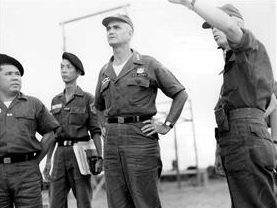 Maddox. The Maddox was conducting a De Soto mission in the area. Then, just two days after the first attack, there was another incident, but that attack remains unclear. The Maddox, joined by destroyer USS C. Turner Joy, engaged what were thought to be more attacking North Vietnamese patrol boats.
Maddox. The Maddox was conducting a De Soto mission in the area. Then, just two days after the first attack, there was another incident, but that attack remains unclear. The Maddox, joined by destroyer USS C. Turner Joy, engaged what were thought to be more attacking North Vietnamese patrol boats.
There is some question as to whether or not the second attack actually happened, but the incident provided the rationale for retaliatory air attacks against the North Vietnamese and the subsequent Tonkin Gulf Resolution. That became the basis for the initial escalation of the war in Vietnam, and ultimately brought about the insertion of United States combat troops into the area.
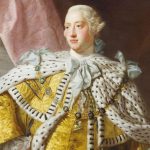 The American Revolution was a serious embarrassment to Britain, and especially to King George III. The king had to admit that things weren’t going well in the colonies…at least not where Britain was concerned. By now, the colonists had signed the Declaration of Independence that summer, and they were not going to be moved from achieving their goal to be a sovereign nation.
The American Revolution was a serious embarrassment to Britain, and especially to King George III. The king had to admit that things weren’t going well in the colonies…at least not where Britain was concerned. By now, the colonists had signed the Declaration of Independence that summer, and they were not going to be moved from achieving their goal to be a sovereign nation.
On this day, October 31, 1776, the king give a speech to the British Parliament, telling them about the signing of the United States Declaration of Independence and the revolutionary leaders who signed it, saying, “for daring and desperate is the spirit of those leaders, whose object has always been dominion and power, that they have now openly renounced all allegiance to the crown, and all political connection with this country.” I’m sure he felt that the colonists were rebels, who were not worth wasting time on by now, and he  hoped he could walk away from them without losing face any more than he already had. The British never intended for the United States to be anything more than the colones. The king went on to inform Parliament of the successful British victory over General George Washington and the Continental Army at the Battle of Long Island on August 27, 1776, but warned them that, “notwithstanding the fair prospect, it was necessary to prepare for another campaign.” Somehow, the king had the idea that there was still hope to keep the colonies.
hoped he could walk away from them without losing face any more than he already had. The British never intended for the United States to be anything more than the colones. The king went on to inform Parliament of the successful British victory over General George Washington and the Continental Army at the Battle of Long Island on August 27, 1776, but warned them that, “notwithstanding the fair prospect, it was necessary to prepare for another campaign.” Somehow, the king had the idea that there was still hope to keep the colonies.
Despite George III’s harsh words, General William Howe and his brother, Admiral Richard Howe, still hoped to convince the Americans to rejoin the British empire in the wake of the colonists’ humiliating defeat at the Battle of Long Island. They hoped to do 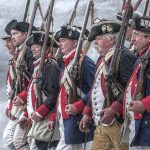 thing peacefully, but that was just not to be. The British could easily have prevented Washington’s retreat from Long Island and captured most of the Patriot officer corps, including the commander in chief. However, instead of forcing the former colonies into submission by executing Washington and his officers as traitors, the Howe brothers let them go with the hope of swaying Patriot opinion towards a return to the mother country. The Howe brothers’ attempts at negotiation failed, and the War for Independence dragged on for another four years, until the formal surrender of the British to the Americans on October 19, 1781, after the Battle of Yorktown. The freedom of the United States was not going to be taken from them…and that was a serious embarrassment to Britain.
thing peacefully, but that was just not to be. The British could easily have prevented Washington’s retreat from Long Island and captured most of the Patriot officer corps, including the commander in chief. However, instead of forcing the former colonies into submission by executing Washington and his officers as traitors, the Howe brothers let them go with the hope of swaying Patriot opinion towards a return to the mother country. The Howe brothers’ attempts at negotiation failed, and the War for Independence dragged on for another four years, until the formal surrender of the British to the Americans on October 19, 1781, after the Battle of Yorktown. The freedom of the United States was not going to be taken from them…and that was a serious embarrassment to Britain.
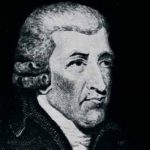
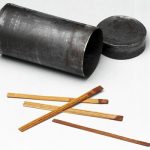 Human beings have always had an interest in fire. Of course, fires have been around…forever, but people didn’t always have the ability to control them, or even get them started. Then 1826, John Walker was stirring a pot of chemicals when he noticed a dried lump had formed on the end of the mixing stick. Without thinking, John tried to scrape the dried glob. Suddenly, the stirring stick ignited. Immediately he knew he had found something amazing. So, he made lots more of his “friction lights” to sell at the local bookstore.
Human beings have always had an interest in fire. Of course, fires have been around…forever, but people didn’t always have the ability to control them, or even get them started. Then 1826, John Walker was stirring a pot of chemicals when he noticed a dried lump had formed on the end of the mixing stick. Without thinking, John tried to scrape the dried glob. Suddenly, the stirring stick ignited. Immediately he knew he had found something amazing. So, he made lots more of his “friction lights” to sell at the local bookstore.
The “friction lights” were three inches long and came neatly in a box with a piece of sandpaper. Walker wasn’t interested in patenting the idea, so Samuel Jones copied the matches and sold “Lucifers.” They were a little more practical than Walker’s friction lights. Lucifers were shorter and came in a smaller cardboard box for easy carrying. Too bad John Walker didn’t patent his product. Imagine how rich he would have become. Matches are still used in lots of places.
A Chinese book titled “Records of the Unworldly and the Strange,” by Tao Gu, makes reference to the earliest description of a match-like product. They were called “fire-inch sticks” and used sulfur to start the flame. Still, they were not strikeable, which makes me wonder how they worked exactly. French chemist Jean Chancel invented the first self-igniting match in 1805. Mr. Chancel’s method involved a wooden splint tipped with sugar and potassium chlorate that was carefully dipped into a small bottle of concentrated sulfuric acid. Chancel’s 
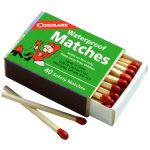 method was highly unpleasant and dangerous. The mix of chemicals produced a yellow smelly gas called chlorine dioxide, which explodes when it comes into contact with pretty much anything. Today, matches are made with non-poisonous red phosphorus, discovered by Johan Edvard Lundstrom. The Diamond Match Company was the first to sell “safety matches” in the United States, forfeiting their patent rights to allow all match companies to produce safe matches. Still, we can trace it all back to the accidental invention of John walker, pharmacist.
method was highly unpleasant and dangerous. The mix of chemicals produced a yellow smelly gas called chlorine dioxide, which explodes when it comes into contact with pretty much anything. Today, matches are made with non-poisonous red phosphorus, discovered by Johan Edvard Lundstrom. The Diamond Match Company was the first to sell “safety matches” in the United States, forfeiting their patent rights to allow all match companies to produce safe matches. Still, we can trace it all back to the accidental invention of John walker, pharmacist.
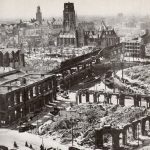 After World War II, most of Europe was in a big mess, whether it was the land,the cities and towns, or the government. There were scores of dead people around, countries and borders were torn apart, most of Europe had been “ground into a very civilized kind of pudding…and the USSR was knocking on the door to come and raid the fridge…so to speak.” Russia would have loved to sneak in and take over when they were at their most vulnerable. The people looked to the United States to figure out away to keep them safe, but not to occupy their countries, per se. That is a rather tall order, but one that the United States took seriously.
After World War II, most of Europe was in a big mess, whether it was the land,the cities and towns, or the government. There were scores of dead people around, countries and borders were torn apart, most of Europe had been “ground into a very civilized kind of pudding…and the USSR was knocking on the door to come and raid the fridge…so to speak.” Russia would have loved to sneak in and take over when they were at their most vulnerable. The people looked to the United States to figure out away to keep them safe, but not to occupy their countries, per se. That is a rather tall order, but one that the United States took seriously.
So the United States came up with Operation Gladio. Basically, they installed a secret military that would unofficially operate all across Europe. The secret military would have one and only one goal…combating communism. Little is known about this secret military, even today, because it wouldn’t be a very good secret army if we knew all about them. So, facts are pretty limited, but it’s not some crazy theory either. Their existence has been confirmed, and the network has been associated with such high-stakes super-evil events, as an attempted pope assassination, large scale bombings, and kidnappings of several high-level government officials. They were willing to do anything to fight communism…murder, extortion, even seemingly becoming communists, if that’s what it took. It turns out that the Italian branch was a particularly active group. An entirely different president of Italy, Francesco Cossiga, was involved in this ominous anti-communism secret society. The reason we don’t know more about them, even years after the end of the Cold War, is simple: crazy, crazy murders. Their secrets will follow them to the grave.
Then a new Italian president was elected. President Aldo Moro, wanted to allow communists to run for office.The still operating Gladio could not let this happen. He was suddenly kidnapped and eventually executed. 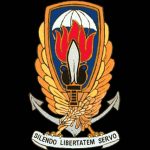 His body was found in the trunk of a car parked next to an ancient gladiatorial site. A warning to others…more than probably!! A “gladio” is an ancient Roman short sword, used in arena combat. A former colonel of Gladio operations in Switzerland decided to write a letter to the government stating that he was ready to “reveal the whole truth.” Again, Operation Gladio took action. The Gladio colonel was found dead in his home a month later. He was stabbed to death with his own bayonet. There were a series of mysterious characters written on his chest that couldn’t be deciphered. Of course, that’s not concrete evidence of Gladio’s direct involvement in these events, but these are just two brutal, worrying events that spin a web of mystery and fear that keeps further investigations from being opened. Sometimes, it’s best to let sleeping dogs lie.
His body was found in the trunk of a car parked next to an ancient gladiatorial site. A warning to others…more than probably!! A “gladio” is an ancient Roman short sword, used in arena combat. A former colonel of Gladio operations in Switzerland decided to write a letter to the government stating that he was ready to “reveal the whole truth.” Again, Operation Gladio took action. The Gladio colonel was found dead in his home a month later. He was stabbed to death with his own bayonet. There were a series of mysterious characters written on his chest that couldn’t be deciphered. Of course, that’s not concrete evidence of Gladio’s direct involvement in these events, but these are just two brutal, worrying events that spin a web of mystery and fear that keeps further investigations from being opened. Sometimes, it’s best to let sleeping dogs lie.
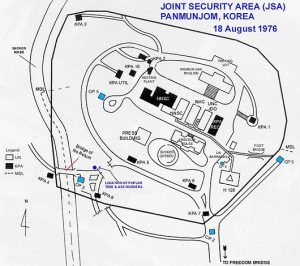 After the August 18, 1976 ace murder of two United States Army officers, Captain Arthur Bonifas and Lieutenant Mark Barrett, by North Korean soldiers, in the Joint Security Area located in the North Korean Demilitarized Zone, it was decided that something had to be done about a certain poplar tree that blocked the view of UN observers, allowing them to be assaulted and killed by the North Koreans, who claimed that the tree had been planted by Kim Il-Sung. It was dubbed the Panmunjom axe murder incident, and it was infuriating to the United States.
After the August 18, 1976 ace murder of two United States Army officers, Captain Arthur Bonifas and Lieutenant Mark Barrett, by North Korean soldiers, in the Joint Security Area located in the North Korean Demilitarized Zone, it was decided that something had to be done about a certain poplar tree that blocked the view of UN observers, allowing them to be assaulted and killed by the North Koreans, who claimed that the tree had been planted by Kim Il-Sung. It was dubbed the Panmunjom axe murder incident, and it was infuriating to the United States.
Three days later, American and South Korean forces launched Operation Paul Bunyan. There was one objective to Operation Paul Bunyan…cut down the tree with a show of force to intimidate North Korea into backing down. Operation Paul Bunyan was carried out on August 21 at 07:00, three days after the killings. A convoy of 23 American and South Korean vehicles, known as “Task Force Vierra”, named after Lieutenant Colonel Victor Vierra, commander of the United States Army Support Group, drove into the JSA without any warning to the North Koreans. There was just one observation post manned at that hour. The vehicles contained two eight-man teams of military engineers from the 2nd Engineer Battalion, 2nd Infantry Division, equipped with chain-saws to cut down the tree. Accompanying these teams were two 30-man security platoons from the Joint Security Force, who were armed with pistols and axe handles. The 1st Platoon secured the northern entrance to the JSA via the Bridge of No Return, while the 2nd Platoon secured the southern edge of the area. A team from B Company, commanded by Captain Walter Seifried, activated the detonation systems for the charges on Freedom Bridge and had the 165mm main gun of the M728 combat engineer vehicle aimed mid-span to ensure that the bridge would fall should the order be given for its destruction.
B Company, supporting E Company (bridge), were building M4T6 rafts on the Imjin River should the situation require emergency evacuation by that route. An additional 64-man task force of the South Korean Special Forces accompanied them, armed with clubs and trained in Tae Kwon Do, supposedly without firearms. Once 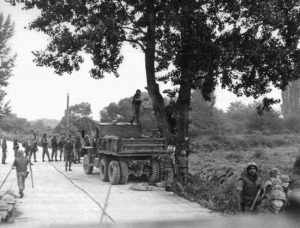 they parked their trucks near the Bridge of No Return, however, they started throwing out the sandbags that lined the truck bottoms, and handing out M16 rifles and M79 grenade launchers that had been concealed below. Several of the commandos also had M18 Claymore mines strapped to their chests with the firing mechanism in their hands, and were shouting at the North Koreans to cross the bridge. A U.S. Infantry company in 20 utility helicopters and seven Cobra attack helicopters circled behind them. Behind these helicopters, B-52 Stratofortresses, came from Guam escorted by US F-4 Phantom IIs from Kunsan Air Base and South Korean F-5 and F-86 fighters were visible flying across the sky at high altitude. At Taegu Air Base, F-111 bombers of the 366th Tactical Fighter Wing out of Mountain Home Air Force Base, were stationed, and F-4 Phantoms C and D from the 18th TFW Kadena Air Base and Clark Air Base were also deployed. The aircraft carrier USS Midway task force had also been moved to a station just offshore. Near the edges of the DMZ, many more heavily armed U.S. and South Korean infantry, artillery including the Second Battalion, 71st Air Defense Regiment armed with Improved Hawk missiles, and armor were waiting to back up the special operations team. Bases near the DMZ were prepared for demolition in case of a military response. The defense condition (DEFCON) was elevated on order of General Stilwell, as recounted in Colonel De LaTeur’s research paper later. 12,000 additional troops were ordered to Korea, including 1,800 Marines from Okinawa. During the operation, nuclear-capable strategic bombers circled over the JSA. According to an intelligence analyst monitoring the North Korea tactical radio net, the accumulation of force “blew their… minds.” Altogether, Task Force Vierra consisted of 813 men: almost all of the men of the United States Army Support Group, of which the Joint Security Force was a part; a South Korean reconnaissance company; a South Korean Special Forces company which had infiltrated the river area by the bridge the night before; and members of a reinforced composite rifle company from the 9th Infantry Regiment. In addition to this force, every UNC force in the rest of South Korea was on battle alert.
they parked their trucks near the Bridge of No Return, however, they started throwing out the sandbags that lined the truck bottoms, and handing out M16 rifles and M79 grenade launchers that had been concealed below. Several of the commandos also had M18 Claymore mines strapped to their chests with the firing mechanism in their hands, and were shouting at the North Koreans to cross the bridge. A U.S. Infantry company in 20 utility helicopters and seven Cobra attack helicopters circled behind them. Behind these helicopters, B-52 Stratofortresses, came from Guam escorted by US F-4 Phantom IIs from Kunsan Air Base and South Korean F-5 and F-86 fighters were visible flying across the sky at high altitude. At Taegu Air Base, F-111 bombers of the 366th Tactical Fighter Wing out of Mountain Home Air Force Base, were stationed, and F-4 Phantoms C and D from the 18th TFW Kadena Air Base and Clark Air Base were also deployed. The aircraft carrier USS Midway task force had also been moved to a station just offshore. Near the edges of the DMZ, many more heavily armed U.S. and South Korean infantry, artillery including the Second Battalion, 71st Air Defense Regiment armed with Improved Hawk missiles, and armor were waiting to back up the special operations team. Bases near the DMZ were prepared for demolition in case of a military response. The defense condition (DEFCON) was elevated on order of General Stilwell, as recounted in Colonel De LaTeur’s research paper later. 12,000 additional troops were ordered to Korea, including 1,800 Marines from Okinawa. During the operation, nuclear-capable strategic bombers circled over the JSA. According to an intelligence analyst monitoring the North Korea tactical radio net, the accumulation of force “blew their… minds.” Altogether, Task Force Vierra consisted of 813 men: almost all of the men of the United States Army Support Group, of which the Joint Security Force was a part; a South Korean reconnaissance company; a South Korean Special Forces company which had infiltrated the river area by the bridge the night before; and members of a reinforced composite rifle company from the 9th Infantry Regiment. In addition to this force, every UNC force in the rest of South Korea was on battle alert.
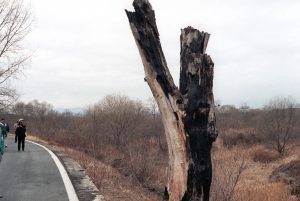
All this to cut down one tree!! My first thought on all this was…overkill, to the extreme!! That’s what I thought at first, but after researching the operation more, I realized that this was as much a show of force, as it was a way to cut down a tree that was really blocking a view that was necessary for keeping soldiers safe. North Korea needed to be shown what could come of such an attack, should it ever happen again. And it worked…North Korea accepted responsibility for the earlier killings. The incident is also known alternatively as the hatchet incident, the poplar tree incident, and the tree trimming incident. Final loss of life, two American Army officers, and one poplar tree.
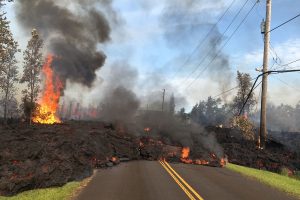 On this day, August 21, 1959, the United States as we know it was completed with the addition of the 50th State… Hawaii. It is the only state that is completely comprised of islands…volcanic islands. Hawaii has another unique feature besides being an island state. That unique feature is that it is the only state that is naturally increasing in size. Most of us immediately think of the current eruptions of Kilauea, and that is a big part of the grown of Hawaii, but it is not the only cause of the growth.
On this day, August 21, 1959, the United States as we know it was completed with the addition of the 50th State… Hawaii. It is the only state that is completely comprised of islands…volcanic islands. Hawaii has another unique feature besides being an island state. That unique feature is that it is the only state that is naturally increasing in size. Most of us immediately think of the current eruptions of Kilauea, and that is a big part of the grown of Hawaii, but it is not the only cause of the growth.
Not every addition to the Big Island involves an eruption that puts people at risk and engulfs their communities. For decades, Kilauea has experienced continuous lava flows through a vent called Pu?u ???? in Hawaii Volcanoes National Park, incrementally adding land to the southeast portion of the island. This continuous flow has added 570 acres of land to Hawaii’s Big Island since 1983, according to the U.S. Geological Survey’s most recent 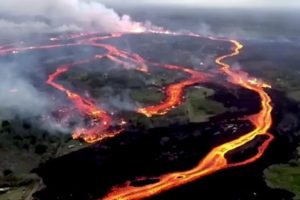 update. Unfortunately, the lava has also buried over 40 square miles of rain forest, communities, and historical sites. Hawaii is an ever-changing place, and the lava doesn’t care about such things as rain forests, communities, and historical sites.
update. Unfortunately, the lava has also buried over 40 square miles of rain forest, communities, and historical sites. Hawaii is an ever-changing place, and the lava doesn’t care about such things as rain forests, communities, and historical sites.
The current stories of the eruption of Kilauea has continued to shock the world, but in reality, Kilauea has been continuously erupting since 1983. Still, on May 3, 2018, the volcano erupted dramatically. The eruption occurred several hours after a magnitude-5.0 quake struck the Big Island. With the eruption came lava flows into residential subdivisions in the Puna district of the Big Island. This prompted mandatory evacuations of the Leilani Estates and Lanipuna Gardens subdivisions. Scientists have two theories about the formation of the Hawaiian Islands. Unlike most volcanoes, the Hawaiian chain sits squarely in the middle of the Pacific plate rather than on a tectonic boundary.

In 1963, J Tuzo Wilson proposed the “hotspot theory” to explain this unusual placement. Wilson proposed that the linear geography of the Hawaiian Islands is due to the movement of the Pacific plate over a stationary point of great heat from deep within the Earth. I have to wonder if that movement is exactly what is causing the current continuing flow of lava from Kilauea. I seems to me that it would be difficult for the lava flow to seal itself when the fault keeps breaking the seal. I could be totally wrong, or I could just be looking at this in a far too simplistic manner. Nevertheless, it seems logical to me. Or maybe that is exactly what Wilson was saying.
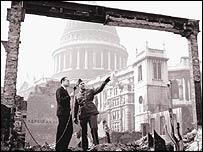 In March or 1941, the United States was largely considered neutral, so we could provide the countries, who were fighting Adolf Hitler, with war material. It was during this period of time, that the United Kingdom, an old enemy of the United States, since the United States fought against them for our independence, needed our help. Of course, we were allies by that time, and so the thought of a loan to the UK was not out o the question. The UK had been fighting against Adolf Hitler’s Germany army for a while by then, and funds were dwindling. The US loaned $4.33 billion to Britain in 1945, while Canada loaned US$1.19 billion in 1946, at a rate of 2% annual interest. It was a good deal, but in the end, the amount paid back was nearly double the amounts loaned in 1945 and 1946.
In March or 1941, the United States was largely considered neutral, so we could provide the countries, who were fighting Adolf Hitler, with war material. It was during this period of time, that the United Kingdom, an old enemy of the United States, since the United States fought against them for our independence, needed our help. Of course, we were allies by that time, and so the thought of a loan to the UK was not out o the question. The UK had been fighting against Adolf Hitler’s Germany army for a while by then, and funds were dwindling. The US loaned $4.33 billion to Britain in 1945, while Canada loaned US$1.19 billion in 1946, at a rate of 2% annual interest. It was a good deal, but in the end, the amount paid back was nearly double the amounts loaned in 1945 and 1946.
The United States was pulled into World War II shortly after, when Japan attacked Pearl Harbor. That marked to end of the program to provide military materials, because the United States was no longer considered neutral. At this point, the United States was very much needed in a very different way, and could not be neutral and be an effective help, but they also had a score to settle, and it could not be handled on the sidelines. The United States had hoped to sit this one out, but that was not to be. The Axis of Evil was winning against the Allied Nations, and they needed help, but it was the boldness of the attack on Pearl Harbor that finally awoke the sleeping giant that was the United States. The United States victory over Japan in the Battle of Midway was the turning point of the war in the Pacific. Then Germany invaded the Soviet Union. The Soviet Union defeated Germany at Stalingrad, marking the turning point of the war in Eastern Europe. As we all know, in the end the Allies were victorious in World War II.
There are still World War I debts owed to and by Britain. Since a moratorium on all debts from that conflict was agreed at the height of the Great Depression, no repayments have been made to or received from other nations since 1934. Despite the favorable rates there were six years in which Britain deferred payment because of economic or political crises. Britain settled its World War II debts to the United States and Canada when it paid the final 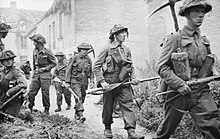 two installments in 2006. The payments of $83.25 million to the US and US$22.7 million to Canada are the last of 50 installments since 1950. Upon the final payments, the UK will have paid back a total of $7.5 billion to the US and US$2 billion to Canada. “This week we finally honor in full our commitments to the United States and Canada for the support they gave us 60 years ago,” said Treasury Minister Ed Balls at the time of those final payments. “It was vital support which helped Britain defeat Nazi Germany and secure peace and prosperity in the post-war period. We honor our commitments to them now as they honored their commitments to us all those years ago,” he added.
two installments in 2006. The payments of $83.25 million to the US and US$22.7 million to Canada are the last of 50 installments since 1950. Upon the final payments, the UK will have paid back a total of $7.5 billion to the US and US$2 billion to Canada. “This week we finally honor in full our commitments to the United States and Canada for the support they gave us 60 years ago,” said Treasury Minister Ed Balls at the time of those final payments. “It was vital support which helped Britain defeat Nazi Germany and secure peace and prosperity in the post-war period. We honor our commitments to them now as they honored their commitments to us all those years ago,” he added.
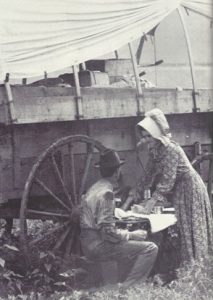 When we think of the Old West, the Pioneer movement, the Gold Rush, and generally, the settling of the United States, our minds immediately go to the brave men who fought the Indians, ran the wagon trains, weathered the harsh winters looking for their fortunes, and fought in the wars to make this a free nation, but seldom do we think of the anonymous heroes of that time…the women. There is a saying, “Behind every great man there’s a great woman.” that saying is one reference to the many women who have set aside their own comforts to support their man in the goals and dreams he has. In many ways that saying is the picture of the Pioneer woman, but it actually leaves something out. Just because her man did not become famous, doesn’t mean that the woman was any less behind him, supporting him in all he did.
When we think of the Old West, the Pioneer movement, the Gold Rush, and generally, the settling of the United States, our minds immediately go to the brave men who fought the Indians, ran the wagon trains, weathered the harsh winters looking for their fortunes, and fought in the wars to make this a free nation, but seldom do we think of the anonymous heroes of that time…the women. There is a saying, “Behind every great man there’s a great woman.” that saying is one reference to the many women who have set aside their own comforts to support their man in the goals and dreams he has. In many ways that saying is the picture of the Pioneer woman, but it actually leaves something out. Just because her man did not become famous, doesn’t mean that the woman was any less behind him, supporting him in all he did.
Pioneer women were there, on the home front, working hard all day trying to keep their house clean in a rugged windswept frontier. Her floors were often made of dirt, and yet she swept them. The water came from a well, or a nearby creek, and she had to haul it into the house, because her man was off hunting to bring in food for the family. The house was crudely constructed with logs and often had a sod roof, and she was right there working like a man beside her husband to get that house built. She watched over the children, and kept them safe from the many perils that were a daily encounter. From snakes, to bears, to mountain lions, to Indians, she did what she needed to, even to the point of handling a gun as well as her husband did. And yet, history looked at her as the weaker part of the partnership, the one who needed to be sheltered and protected. History looked at her as if she could not 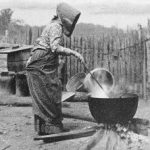 even bear to hear about certain things, because they might be too upsetting to her. In reality, they had vastly underestimated their women.
even bear to hear about certain things, because they might be too upsetting to her. In reality, they had vastly underestimated their women.
When the men got hurt, and the garden needed to be cared for, the women would till the ground…fighting with the tiller behind a horse, and winning the battle. These women took care of the house, the children, the sick or injured husband, and the garden or other crops, all without batting an eye. These women knew all about the hardships of frontier living, and when the going got tough, they didn’t turn and run back east. When the Indians attacked, they stayed and fought with their men. They could not afford to hide in a cellar, their hands were needed to hold a gun. They even faced the Indians alone, when their men were away, becoming excellent negotiators, who were able to make a trade of their wares that, in the end saved their own lives and the lives of their families. They were determined to make this new frontier work, and for the most part, they did it all without making a name for themselves. Sometimes, when we look up ancestors in historic archives, these women are either listed only as Mrs, acknowledging only the husband’s name, or they were listed only as the wife of their husband. Their true identity sometimes remains forever a mystery, and yet, they were heroes…but, they were anonymous heroes. The great men they stood behind, thereby making these men successful, may have been heroes of the frontier, and their name may have been one that every history book told us all about, 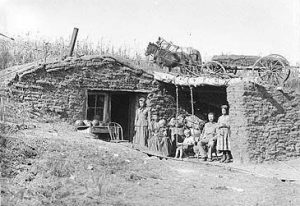 but their wives, who worked quietly beside them, remained unknown. We knew about the exploits of the men, the towns they founded, the travels they made exploring ever westward, but the women who were there with them, cooking the meals while the men talked, cleaning up afterward alone, delivering their babies often with only the help of their husband, carrying a baby, while weeding a garden, and feeding their family before themselves, going hungry, if necessary, to make sure the family was taken care of…these women rarely made the history books. Their job must have seemed to mundane to be considered adventurous, but without their contribution, this nation would not have become the great Republic that it is.
but their wives, who worked quietly beside them, remained unknown. We knew about the exploits of the men, the towns they founded, the travels they made exploring ever westward, but the women who were there with them, cooking the meals while the men talked, cleaning up afterward alone, delivering their babies often with only the help of their husband, carrying a baby, while weeding a garden, and feeding their family before themselves, going hungry, if necessary, to make sure the family was taken care of…these women rarely made the history books. Their job must have seemed to mundane to be considered adventurous, but without their contribution, this nation would not have become the great Republic that it is.
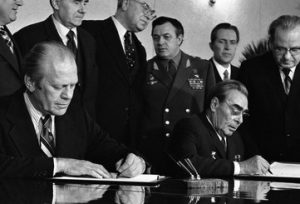 During the Cold War, the threat of a nuclear attack was the biggest concern in world relationships. During the late 1960s, the United States learned that the Soviet Union had embarked upon a massive Intercontinental Ballistic Missile (ICBM) buildup designed to catch up with the United States. The situation seemed to be heating up, because the Soviet Union seemed far more likely to use such weapons, so it looked like it was time to take action. In January 1967, President Lyndon Johnson announced that the Soviet Union had begun to construct a limited Anti-Ballistic Missile (ABM) defense system around Moscow. The development of an ABM system could allow one side to launch a first strike and then prevent the other from retaliating by shooting down incoming missiles. That was completely unacceptable.
During the Cold War, the threat of a nuclear attack was the biggest concern in world relationships. During the late 1960s, the United States learned that the Soviet Union had embarked upon a massive Intercontinental Ballistic Missile (ICBM) buildup designed to catch up with the United States. The situation seemed to be heating up, because the Soviet Union seemed far more likely to use such weapons, so it looked like it was time to take action. In January 1967, President Lyndon Johnson announced that the Soviet Union had begun to construct a limited Anti-Ballistic Missile (ABM) defense system around Moscow. The development of an ABM system could allow one side to launch a first strike and then prevent the other from retaliating by shooting down incoming missiles. That was completely unacceptable.
President Johnson decided to call for strategic arms limitations talks…nicknamed SALT, and in 1967, he and Soviet Premier Alexei Kosygin met at Glassboro State College in New Jersey. Johnson said they must gain “control of the ABM race,” and Secretary of Defense Robert McNamara argued that the more each reacted to the other’s escalation, the more they had chosen “an insane road to follow.” Completely abolishing nuclear weapons would be impossible, but limiting the development of both offensive and defensive strategic systems could be done, and it might help stabilize relations between the  United States and the Soviet Union. The resulting SALT-I treaty was signed in 1972. The 1972 treaty limited a wide variety of nuclear weapons, but it did not address many of the other issues, so shortly after the SALT-I treaty was ratified, talks between the United States and the Soviet Union began anew. Those talks failed to achieve any new breakthroughs. By 1979, both the United States and the Soviet Union were eager to try again. For the United States, the thought that the Soviets were leaping ahead in the arms race was the primary motivator. For the Soviet Union, the increasingly close relationship between America and communist China was a cause for growing concern.
United States and the Soviet Union. The resulting SALT-I treaty was signed in 1972. The 1972 treaty limited a wide variety of nuclear weapons, but it did not address many of the other issues, so shortly after the SALT-I treaty was ratified, talks between the United States and the Soviet Union began anew. Those talks failed to achieve any new breakthroughs. By 1979, both the United States and the Soviet Union were eager to try again. For the United States, the thought that the Soviets were leaping ahead in the arms race was the primary motivator. For the Soviet Union, the increasingly close relationship between America and communist China was a cause for growing concern.
The SALT-II agreement was the result of those many nagging issues that were left over from the successful SALT-I treaty of 1972, but it had problems of its own. The treaty basically established numerical equality between the two nations in terms of nuclear weapons delivery systems. It also limited the number of MIRV missiles (missiles with multiple, independent nuclear warheads). In truth, the treaty did little or nothing to stop, or even substantially slow down, the arms race, and it met with unrelenting criticism in the United States. The treaty was thought to be a “sellout” to the Soviets. People believed that it would leave America virtually defenseless against a whole range of new weapons not mentioned in the agreement. Even supporters of arms control were less than enthusiastic about the treaty, since it did little to actually control arms. Nevertheless, during a summit meeting in Vienna, President Jimmy Carter and Soviet leader Leonid Brezhnev signed the 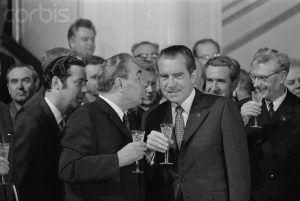 SALT-II agreement dealing with limitations and guidelines for nuclear weapons, on June 18, 1979. The treaty, would never formally go into effect, and it proved to be one of the most controversial agreements between the United States and the Soviet Union of the entire Cold War. Debate over SALT-II in the U.S. Congress continued for months. Then in December 1979, the Soviets invaded Afghanistan. The Soviet attack effectively killed any chance of SALT-II being passed, and Carter ensured this by withdrawing the treaty from the Senate in January 1980. SALT-II thus remained signed, but was never ratified. During the 1980s, both nations agreed to respect the agreement until such time as new arms negotiations could take place.
SALT-II agreement dealing with limitations and guidelines for nuclear weapons, on June 18, 1979. The treaty, would never formally go into effect, and it proved to be one of the most controversial agreements between the United States and the Soviet Union of the entire Cold War. Debate over SALT-II in the U.S. Congress continued for months. Then in December 1979, the Soviets invaded Afghanistan. The Soviet attack effectively killed any chance of SALT-II being passed, and Carter ensured this by withdrawing the treaty from the Senate in January 1980. SALT-II thus remained signed, but was never ratified. During the 1980s, both nations agreed to respect the agreement until such time as new arms negotiations could take place.
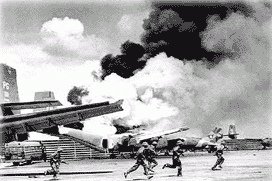 From November 1, 1955 until April 30, 1975, the Vietnam war raged. The United States entered the war on March 8, 1965. It was an unpopular war from the start. Those who protested US involvement felt like it wasn’t our war and we shouldn’t be there. Be that as it may, we were there, and for the time being, we weren’t going anywhere. The war was a long one, but on April 30, 1975, it came to an abrupt end, when Saigon fell.
From November 1, 1955 until April 30, 1975, the Vietnam war raged. The United States entered the war on March 8, 1965. It was an unpopular war from the start. Those who protested US involvement felt like it wasn’t our war and we shouldn’t be there. Be that as it may, we were there, and for the time being, we weren’t going anywhere. The war was a long one, but on April 30, 1975, it came to an abrupt end, when Saigon fell.
At dawn that spring morning, communist forces moved into Saigon, where they received only sporadic resistance. The South Vietnamese forces had collapsed under the rapid advancement of the North Vietnamese. The most recent fighting had begun in December 1974. That was when the North Vietnamese launched a major attack against the lightly defended province of Phuoc Long, which was located due north of Saigon along the Cambodian border, overrunning the provincial capital at Phuoc Binh on January 6, 1975. Despite previous promises, from President Nixon, to provide aid if the communists attacked Saigon, the United States did nothing. The problem…Nixon had resigned from office and his successor, Gerald Ford, was unable to convince a hostile Congress to keep Nixon’s earlier promises to rescue Saigon from communist takeover. The United States had its own set of tumultuous circumstances to deal with at that time.
The lack of response from the United States emboldened the North Vietnamese, who launched a new campaign 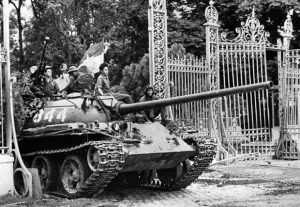 in March 1975. The South Vietnamese forces fell back in total chaos, and once again, the United States did nothing. The South Vietnamese abandoned Pleiku and Kontum in the Highlands with little to no fighting. Then Quang Tri, Hue, and Da Nang fell to the communist onslaught. The North Vietnamese continued to attack south along the coast toward Saigon, defeating the South Vietnamese forces at each encounter.
in March 1975. The South Vietnamese forces fell back in total chaos, and once again, the United States did nothing. The South Vietnamese abandoned Pleiku and Kontum in the Highlands with little to no fighting. Then Quang Tri, Hue, and Da Nang fell to the communist onslaught. The North Vietnamese continued to attack south along the coast toward Saigon, defeating the South Vietnamese forces at each encounter.
The South Vietnamese 18th Division had fought a valiant battle at Xuan Loc, just to the east of Saigon, destroying three North Vietnamese divisions in the process. They were the only division that seemed capable of continuing the fight. That was to be the last battle in the defense of the Republic of South Vietnam. The South Vietnamese forces held out against the attackers until they ran out of tactical air support and weapons, finally abandoning Xuan Loc to the communists on April 21, 1975.
Having crushed the last major organized opposition before Saigon, the North Vietnamese got into position for the final assault. In Saigon, South Vietnamese President Nguyen Van Thieu resigned and transferred authority to Vice President Tran Van Huong before fleeing the city on April 25. By April 27, the North Vietnamese had  completely encircled Saigon and began to maneuver for a complete takeover. When they attacked at dawn on April 30, they met little resistance. North Vietnamese tanks crashed through the gates of the Presidential Palace and the war came to an end. North Vietnamese Colonel Bui Tin accepted the surrender from General Duong Van Minh, who had taken over after Tran Van Huong and had only spent only one day in power. Tin explained to Minh, “You have nothing to fear. Between Vietnamese there are no victors and no vanquished. Only the Americans have been beaten. If you are patriots, consider this a moment of joy. The war for our country is over.” Of course, this also meant that Vietnam would be a Communist country, like it or not.
completely encircled Saigon and began to maneuver for a complete takeover. When they attacked at dawn on April 30, they met little resistance. North Vietnamese tanks crashed through the gates of the Presidential Palace and the war came to an end. North Vietnamese Colonel Bui Tin accepted the surrender from General Duong Van Minh, who had taken over after Tran Van Huong and had only spent only one day in power. Tin explained to Minh, “You have nothing to fear. Between Vietnamese there are no victors and no vanquished. Only the Americans have been beaten. If you are patriots, consider this a moment of joy. The war for our country is over.” Of course, this also meant that Vietnam would be a Communist country, like it or not.

